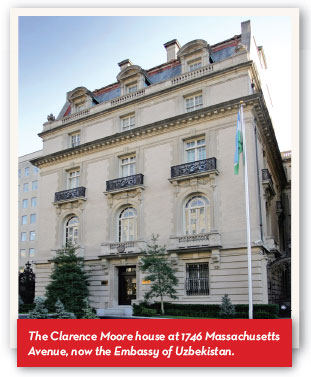 Pierre L’Enfant. De Sibour is best remembered
for the private mansions he designed up and
down Massachusetts Avenue on Embassy Row,
which are now residences, chanceries
and embassies of Canada, Columbia,
France, Luxembourg, Peru, Portugal,
Spain and Uzbekistan. These buildings
reflect de Sibour’s genius as a master
synthesizer of the French Beaux Arts
style and American tastes of the time.
It is ironic that de Sibour became
an architect by accident. He didn’t
know what he wanted to do after he
graduated from Yale, so his architect
brother Louis got him a job at a
prestigious design firm in New York.
De Sibour was not happy there and probably
would have left the profession, had it not
been for the renowned architect Bruce Price,
who became his mentor. De Sibour joined
Price’s firm, then took his boss’s advice and
went to Paris to study at the same school
Louis had attended, the world-famous Ecole
des Beaux Arts.
De Sibour practiced in New York, then
married and moved to Washington in 1909,
where he already had a following. He was
handsome, charming, gregarious and made
friends easily. He became a friend of Clarence
Moore, a coal magnate, who was master of the
hunt at the Chevy Chase Club. De Sibour
designed the clubhouse at Chevy Chase and
Moore’s own magnificent residence. The Beaux
Arts gem at |
In the early 1900s, Dupont Circle rivaled
New York’s upper Fifth Avenue as the
place for prominent and wealthy people
to congregate, and it was the first time
Washington had a concentration of people rich
enough to define themselves by the homes they
built. The captains of industry and commerce were
as wealthy as kings and commissioned houses
as grand as European palaces. Many of them
found the appropriate symbol for their status in
the exuberant Beaux Arts style, and the perfect
architect in Jules Henri de Sibour.
De Sibour had credentials that impressed
his American audience: his mother was from
Maine and his father, Vicomte Gabriel de Sibour,
was a direct descendent of French King Louis
IX. In the 30 years Jules de Sibour worked in
Washington, he produced a staggering number
of private homes, theaters, hotels and office
buildings, from the Folger Library to the Jefferson
Hotel. His elegant McCormick Apartment
Building, which now houses the National Trust
for Historic Preservation, shows the masterful
way he accommodated the Beaux Arts style to
the angular lots of the city’s complicated grid,
which was laid out by an earlier French visionary,
Pierre L’Enfant. De Sibour is best remembered
for the private mansions he designed up and
down Massachusetts Avenue on Embassy Row,
which are now residences, chanceries
and embassies of Canada, Columbia,
France, Luxembourg, Peru, Portugal,
Spain and Uzbekistan. These buildings
reflect de Sibour’s genius as a master
synthesizer of the French Beaux Arts
style and American tastes of the time.
It is ironic that de Sibour became
an architect by accident. He didn’t
know what he wanted to do after he
graduated from Yale, so his architect
brother Louis got him a job at a
prestigious design firm in New York.
De Sibour was not happy there and probably
would have left the profession, had it not
been for the renowned architect Bruce Price,
who became his mentor. De Sibour joined
Price’s firm, then took his boss’s advice and
went to Paris to study at the same school
Louis had attended, the world-famous Ecole
des Beaux Arts.
|
1746 Massachusetts Avenue was
called “one of the finest houses ever erected
in the city” by the AIA Guide to Washington
Architecture. Unfortunately, Moore was never
able to enjoy his new home, because he took
a trip to England to purchase hunting dogs for
the club and booked his return passage on the
one and only voyage of the Titanic.
During the Great Depression, many of
the fine homes were closed up. Few people
who lived in Washington needed ballrooms or
an entire separate floor for servant’s quarters.
Luckily for us, these grand houses were not
torn down, since they were ideally suited as
embassies, consulates and public buildings, and
that’s what they are today.
Thomas Jefferson once predicted that
fine architecture would improve the taste of
his countrymen, “increase their reputation”
among citizens of more established nations,
“reconcile them to the rest of the world and
procure them its praise.” We can only wonder
if the citizens of the new and old nations who
live and work in Jules de Sibour’s
buildings are so reconciled.
Jefferson was right, in as much as
the legacy of de Sibour’s brilliant Beaux
Arts creations provide a bridge between
our younger country and its European
inheritance. And, while these magnificent
buildings may or may not impress visitors
from other countries, their more lasting
value is that they change the way we
who live here see ourselves, our past and
our possibilities.
|

